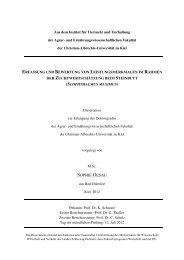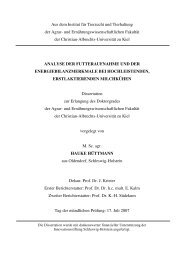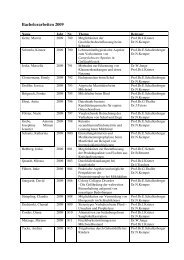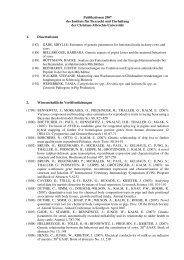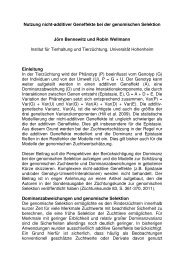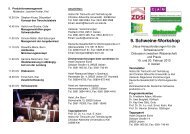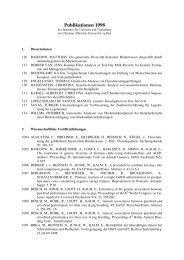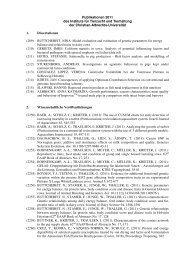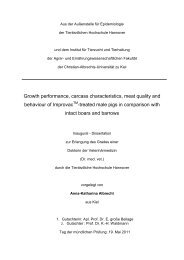Verena Gonzalez Lopez, 2011 - Institut für Tierzucht und Tierhaltung ...
Verena Gonzalez Lopez, 2011 - Institut für Tierzucht und Tierhaltung ...
Verena Gonzalez Lopez, 2011 - Institut für Tierzucht und Tierhaltung ...
Sie wollen auch ein ePaper? Erhöhen Sie die Reichweite Ihrer Titel.
YUMPU macht aus Druck-PDFs automatisch weboptimierte ePaper, die Google liebt.
number of selected boars at different levels of relationship constraints and the<br />
corresponding expected average breeding value of selected animals are shown in<br />
Figure 2.<br />
number of selected boars<br />
22<br />
20<br />
18<br />
16<br />
14<br />
12<br />
10<br />
8<br />
6<br />
4<br />
2<br />
0<br />
selected boars Schleswig-Holstein<br />
selected boars Schleswig-Holstein and Baden-Württemberg<br />
average breeding value Schleswig-Holstein<br />
average breeding value Schleswig-Holstein and Baden-Württemberg<br />
1.9 2.1 2.3 2.5 2.7 2.9 3.1 3.3 3.5 3.7 3.9<br />
constraint on relationship (%)<br />
170<br />
160<br />
150<br />
140<br />
130<br />
120<br />
average breeding value<br />
Figure 2: Average expected breeding value of selected animals and number of selected<br />
sires at different constraints on relationship without restrictions on maximal contributions.<br />
In general, the optimal number of boars decreased rapidly as the relationship<br />
constraint is relaxed. The lowest achievable level of relationship in the next<br />
generation were 2.7% for SH boars and only 1.9% if BW boars were included. The<br />
optimal number of boars at the most stringent constraint was 16 for SH boars and 17<br />
for SH and BW boars, respectively. At the most relaxed relationship constraint<br />
(3.9%), the optimal number of boars decreased to two and one for SH and SH with<br />
BW boars, respectively. Without a constraint on boars reproductive capacity,<br />
expected average breeding value of selected animals was maximized at relationship<br />
constraint at 3.9% for both datasets. However, a higher average breeding value of<br />
selected animals could be achieved by including BW boars.<br />
In a second scenario, the maximum genetic contribution of individual boars was<br />
restricted to 10% which means that the maximum number of progeny from the same<br />
boar is limited to a value of five animals (Figure 3). This constraint led to a loss in<br />
genetic gain. With a maximal contribution of 10% of each selected boar, the maximal<br />
achievable average breeding value of selected animals reduced from 160 to 140<br />
including SH boars. Also a reduction was calculated for SH and BW boars from 163<br />
to 148.<br />
47



